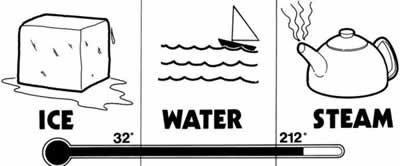Theory of Air Conditioning
The law of entropy states that all things must eventually come to the same temperature; there will always be a flow of heat between adjacent objects that are at different temperatures. When two objects at different temperatures are placed next to each other, heat will flow from the warmer of the two objects to the cooler one. The rate at which heat is transferred depends on how large the difference is between their temperatures. If the temperature difference is great, the transfer of heat will be great, and if the temperature difference lessens, the transfer of heat will be reduced until both objects reach the same temperature. At that point, heat transfer stops.
The refrigeration cycle of the air conditioning system removes the heat from a vehicle's interior by making use of another law of heat flow, the theory of latent heat. This theory says that during a change of state, a material can absorb or reject heat without changing its temperature. A material is changing its state when it is freezing, thawing, boiling or condensing. Changes of state differ from ordinary heating and cooling in that they occur without the temperature of the substance changing, although they cause a visible change in the form of the substance. While many materials can exist in solid, liquid, or gaseous form, the best example is plain water.
Theory of Air Conditioning How Air Conditioning Works Governmental Regulations System Inspection
Water is a common material that can exist in all three states. Below 32°F (0°C), it exists as ice. Above 212°F (100°C), at sea level air pressure, it exists as steam, which is a gas. Between these two temperatures, it exists in its liquid form.
Since a change in state occurs at a constant temperature, it follows that a material can exist as both a liquid and a gas at the same temperature without any exchange of heat between the two states. As an example, when water boils, it absorbs heat without changing the temperature of the resulting gas (steam).
The change from a solid to a liquid and vice versa is always practically the same for a given substance-32°F (0°C) for water-but the temperature at which a liquid will boil or condense depends upon the pressure. For example, water will boil at 212°F (100°C), but only at sea level. The boiling point drops slightly at higher altitudes, where the atmospheric pressure is lower. We also know that raising the pressure 15 lbs. above normal air pressure in an automobile cooling system will keep the water from boiling until the temperature reaches about 260°F (127°C)
One additional aspect of the behavior of a liquid at its boiling point must be clarified to understand how a refrigeration cycle works. Since liquid and gas can exist at the same temperature, either the evaporation of liquid or the condensation of gas can occur at the same temperature and pressure conditions. It's just a matter of whether the material is being heated or cooled.
As an example, when a pan of water is placed on a hot stove, the heat travels from the hot burner to the relatively cool pan and water. When the water reaches it's boiling point, its temperature will stop rising, and all the additional heat forced into it by the hot burner will be used to turn the liquid material into a gas (steam). The gas thus contains slightly more heat than the liquid material.
If the top of the pan were now to be held a couple of inches above the boiling water, two things would happen. First, droplets of liquid would form on the lower surface of the lid. Second, the top would get hot very quickly. The top becomes hot because the heat originally used to turn the water into steam is being recovered. As the vapor encounters the cooler surface of the metal, heat is removed from it and transferred to the metal. This heat is the same heat that was originally required to change the water into a vapor, and so it again becomes a liquid.
Since water will boil only at 212°F (100°C) and above, it follows that the steam must have been 212°F (100°C) when it reached the top and must have remained that hot until it became a liquid. The cooling effect of the top (which started out at room temperature) caused the steam to condense, but both the boiling and the condensation took place at the same temperature.
To sum up, refrigeration is the removal of heat from a confined space and is based on three assumptions:
- Heat will only flow from a warm substance to a colder substance.
- A refrigerant can exist as both a liquid and a gas at the same temperature if it is at its "boiling point." A refrigerant at its boiling point will boil and absorb heat from its surroundings if the surroundings are warmer than the refrigerant. A refrigerant at its boiling point will condense and become liquid, losing heat to its surroundings, if they are cooler than the refrigerant.
- The boiling point of the refrigerant depends upon the pressure of the refrigerant, rising as the pressure rises and falling as the pressure falls. The operation of the refrigeration cycle illustrates how these three laws are put to use.


